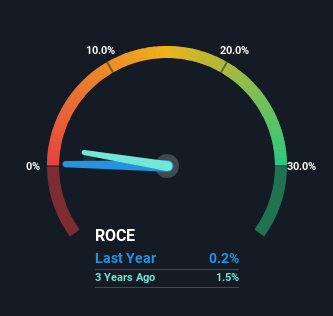- Australia
- /
- Renewable Energy
- /
- ASX:TML
Timah Resources' (ASX:TML) Returns On Capital Not Reflecting Well On The Business

If we're looking to avoid a business that is in decline, what are the trends that can warn us ahead of time? When we see a declining return on capital employed (ROCE) in conjunction with a declining base of capital employed, that's often how a mature business shows signs of aging. Trends like this ultimately mean the business is reducing its investments and also earning less on what it has invested. So after glancing at the trends within Timah Resources (ASX:TML), we weren't too hopeful.
We've discovered 4 warning signs about Timah Resources. View them for free.Return On Capital Employed (ROCE): What Is It?
If you haven't worked with ROCE before, it measures the 'return' (pre-tax profit) a company generates from capital employed in its business. The formula for this calculation on Timah Resources is:
Return on Capital Employed = Earnings Before Interest and Tax (EBIT) ÷ (Total Assets - Current Liabilities)
0.0018 = RM89k ÷ (RM50m - RM526k) (Based on the trailing twelve months to December 2024).
Thus, Timah Resources has an ROCE of 0.2%. In absolute terms, that's a low return and it also under-performs the Renewable Energy industry average of 11%.
Check out our latest analysis for Timah Resources

While the past is not representative of the future, it can be helpful to know how a company has performed historically, which is why we have this chart above. If you're interested in investigating Timah Resources' past further, check out this free graph covering Timah Resources' past earnings, revenue and cash flow.
What The Trend Of ROCE Can Tell Us
The trend of returns that Timah Resources is generating are raising some concerns. The company used to generate 3.7% on its capital five years ago but it has since fallen noticeably. On top of that, the business is utilizing 23% less capital within its operations. When you see both ROCE and capital employed diminishing, it can often be a sign of a mature and shrinking business that might be in structural decline. If these underlying trends continue, we wouldn't be too optimistic going forward.
The Bottom Line On Timah Resources' ROCE
In short, lower returns and decreasing amounts capital employed in the business doesn't fill us with confidence. It should come as no surprise then that the stock has fallen 24% over the last three years, so it looks like investors are recognizing these changes. Unless there is a shift to a more positive trajectory in these metrics, we would look elsewhere.
On a final note, we found 4 warning signs for Timah Resources (3 can't be ignored) you should be aware of.
While Timah Resources isn't earning the highest return, check out this free list of companies that are earning high returns on equity with solid balance sheets.
Valuation is complex, but we're here to simplify it.
Discover if Timah Resources might be undervalued or overvalued with our detailed analysis, featuring fair value estimates, potential risks, dividends, insider trades, and its financial condition.
Access Free AnalysisHave feedback on this article? Concerned about the content? Get in touch with us directly. Alternatively, email editorial-team (at) simplywallst.com.
This article by Simply Wall St is general in nature. We provide commentary based on historical data and analyst forecasts only using an unbiased methodology and our articles are not intended to be financial advice. It does not constitute a recommendation to buy or sell any stock, and does not take account of your objectives, or your financial situation. We aim to bring you long-term focused analysis driven by fundamental data. Note that our analysis may not factor in the latest price-sensitive company announcements or qualitative material. Simply Wall St has no position in any stocks mentioned.
About ASX:TML
Timah Resources
Through its subsidiary, engages in the generation of renewable energy in Australia and Malaysia.
Adequate balance sheet slight.
Market Insights
Community Narratives




